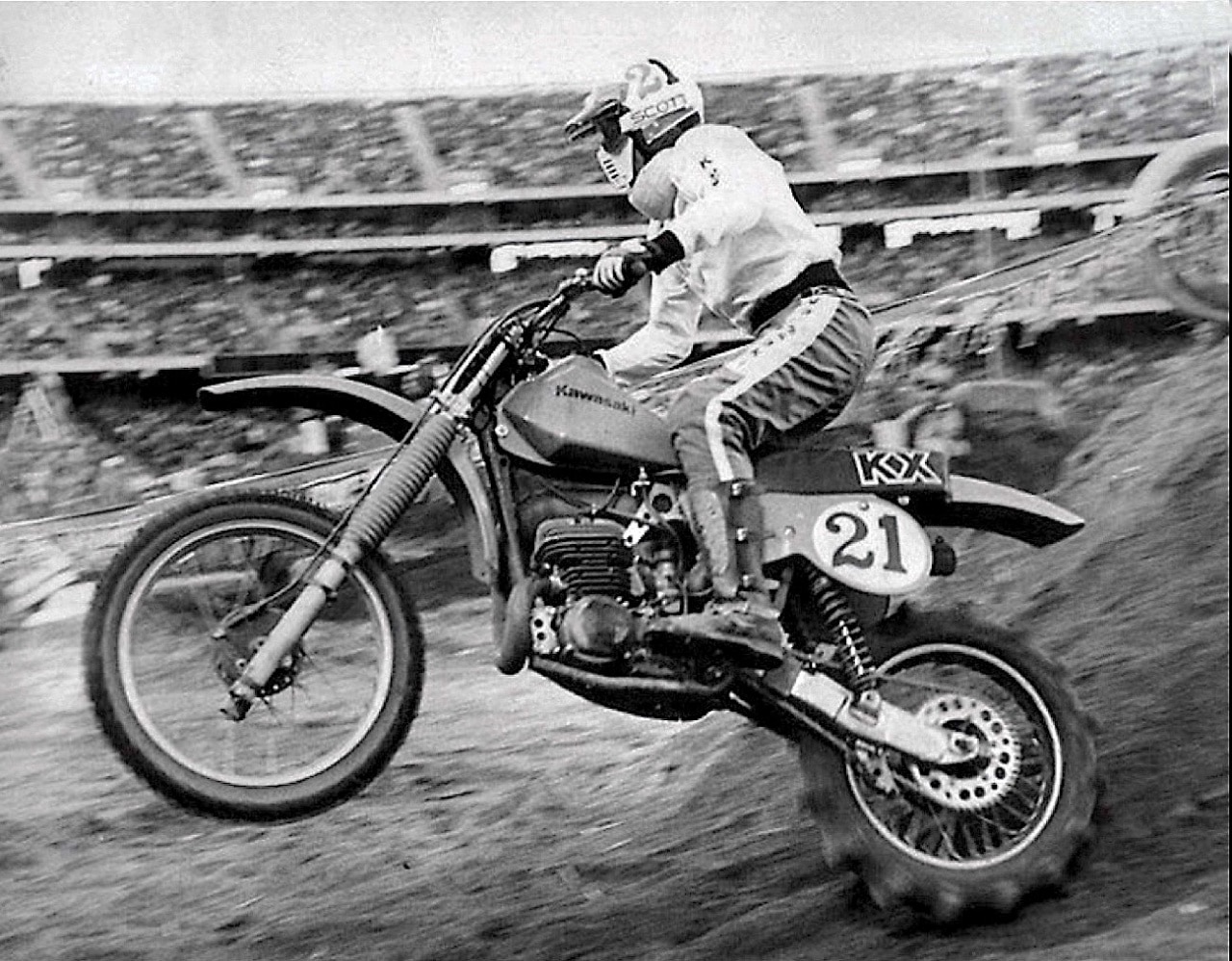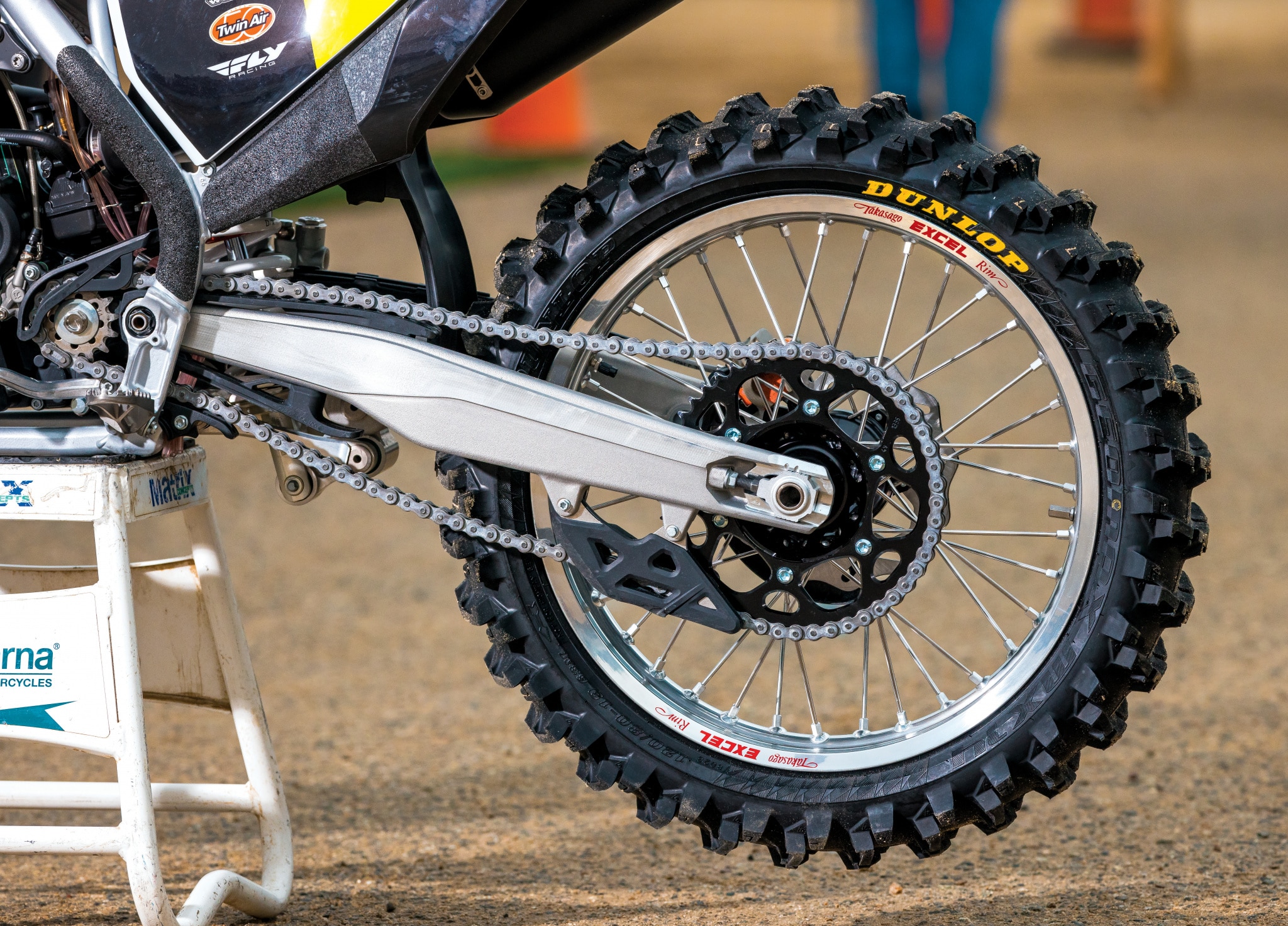TEN THINGS ABOUT THE REVIVAL OF SCOOP TIRES

(1) Tire choices. Tire companies produce a variety of options for specific disciplines. Intermediate-terrain tires (like the Dunlop MX33) are the most popular high-end tires for motocross racing, but there are tracks where hard-terrain tires and/or soft-terrain sand/mud tires come in handy.
(2) Trends. Lately, sand/mud scoop tires have become popular at the races, gaining traction in the dirt and in the press. In Formula 1 and other four-wheeled road course racing, the TV personalities always debate the tire choices of teams and drivers. They discuss soft, medium or hard compounds for different segments of the race and, of course, when to switch to grooved rain tires as inclement weather approaches. In 2022 the tire debate has become a hot topic because Eli Tomac and Antonio Cairoli have elected to run scoop/sand/wet tires, even when the track isn’t soft, sandy or muddy.
(3) Land/sea. The “land/sea ratio” is the term used to describe the relationship between the contact patch of the knobs (land) and the space between them (sea). For soft terrain, less land and more sea equates to knobs that dig deeper into soft terrain for better traction. On hard terrain, more land and less sea creates increased traction on hard-pack dirt by putting more rubber on the road.
(4) Scoop tires. Built for the softest terrain, scoop tires are rear-wheel-specific tires, and they are designed to dig deeper into the soil and gain forward momentum in areas where traditional tires struggle. Scoop tires are made with knobs that are taller, spaced farther apart and uni-directional thanks to their shovel-shaped scooping rows of knobs.
 Jimmy Weinert won the sandy 1979 Oakland Supercross with 16-scoop paddle tire. Photo: Jody Weisel
Jimmy Weinert won the sandy 1979 Oakland Supercross with 16-scoop paddle tire. Photo: Jody Weisel
(5) History. Jimmy Weinert led every lap in his heat race and in the main event at the 1979 Oakland Supercross with a secret weapon. He had a 16-scoop paddle tire called the Hooker. The Oakland track was very sandy, and while everyone else struggled to find traction, Weinert’s paddles dug into the loose stuff and threw a tremendous roost out the back. This wasn’t like the scoop tires we have today; this was a full-scoop tire made for sand dunes and nothing else. Jimmy made it work, because the track was pure beach sand.
(6) AMA Rule. Weeks after Jimmy Weinert’s Oakland win, the AMA put rule 3.15 into the rule book to stop anyone else from ever racing with a paddle tire in the future. The new rules had three major clauses: (A) All tires had to be made of rubber. No studs or metal scoops were allowed. (B) To be legal, tires could not have a continuous radial rib pattern, meaning that any row of knobs had to have open breaks in it. (C) All legal AMA Professional racing tires could not have knobs more than 3/4 of an inch tall. The justification for banning paddle tires was that the roost they threw up behind the bike was so intense that it presented a danger to riders behind it.
(7) Pros and cons. The topic of top riders choosing to use scoop tires is great for TV, because the announcers can visually distinguish them from standard-issue intermediate-terrain tires. It has become a talking point. Additionally, scoop tires allow the riders who choose to run them to take lines through the soft/muddy edges of the track that intermediate tires get bogged down in. On the flip side, scoop tires have very little land and a lot of sea, which means that they have less traction on hard-pack sections of the track, like on the shiny exits of turns. Of course, the tall knobs, just a hair under 3/4 of an inch, work differently under braking and at steep lean angles than intermediate tires.
Zach Osborne ran a Dunlop MX14 on his Husqvarna TC300 at the 2022 World Two-Stroke Championship at Glen Helen.
(8) How it works. Over the years scoop tires have adopted updated tire technology and improved rubber compounds to vastly improve cornering and braking prowess, so much so that Tony and Eli often used them in dirt conditions that would have been taboo three years ago. MXA uses scoop tires in the sand and mud, and for early-morning races whenever we know that the track will be ripped deep and watered heavily. No matter the size of the bike, a scoop tire in the soft dirt makes your bike feel like it has a big-bore kit. You twist the throttle and go without needing to abuse the clutch.

(9) Pro approval. Eli Tomac, Tony Cairoli, Adam Cianciarulo and Zach Osborne have led the pro-scoop movement. Eli Tomacused the scoop tire more than any other rider during the 2022 AMA National Motocross Championship. Even when track conditions looked hard and rain clouds were nowhere in sight, Eli chose the tire because he felt more comfortable on it since he tested and trained on it back home in Colorado. Nine-time World Champion Tony Cairoli used a Pirelli scoop tire during his foray into American racing this past summer.
 This is what it looks like to follow a scoop tire in close formation. Photo:Debbi Tamietti
This is what it looks like to follow a scoop tire in close formation. Photo:Debbi Tamietti
(10) Start. One of the main reasons to choose a scoop tire is to get the holeshot. If the start straight is ripped deep, the scoop tire will get its user to the front. The gamble is whether or not he will be able to stay out front as the racetrack gets hard-packed lines. Our scoop tire advice is to look for soft berms or drop into deep ruts to maximize the scoop tire’s biggest benefits. In other words, head for the soft soil you normally stay away from.






Comments are closed.